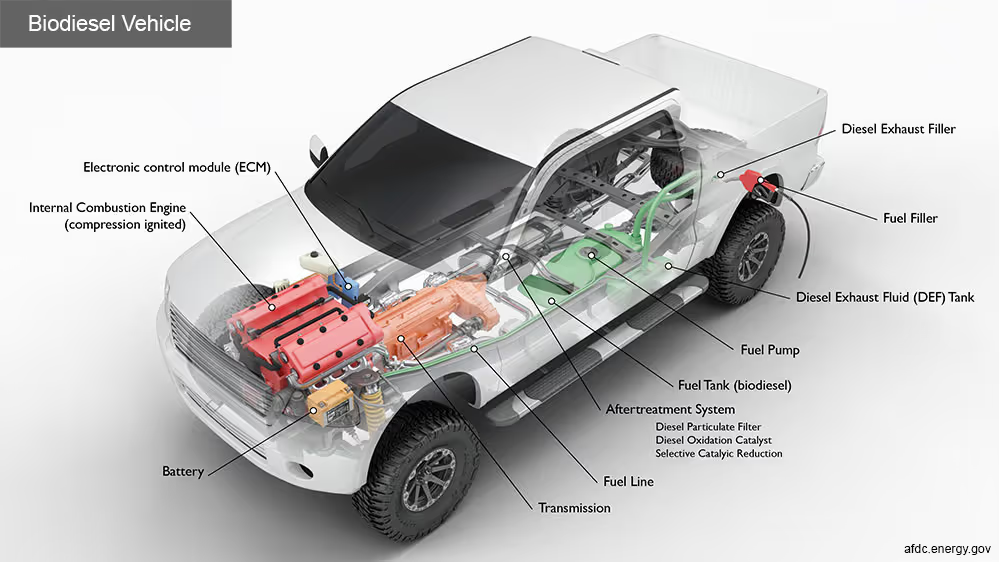California Air Resources Board affirms biodiesel as lowest-carbon fuel in revised LCFS
From The National Biodiesel Board | September 25, 2015
In a fight to reduce greenhouse gas emissions, California’s Air Resources Board has spent years looking for the cleanest, most efficient ways to cut carbon. Turns out, biodiesel is at the top of the list.
On Sept. 25 the board finalized California’s revised low carbon fuel standard. The new standard affirms biodiesel reduces greenhouse gas emissions by at least 50 percent and often by as much as 81 percent vs. petroleum. This gives biodiesel the best carbon score among all liquid fuels.
“Biodiesel is the most sustainable fuel on the planet,” said Don Scott, National Biodiesel Board director of sustainability. “Low carbon alternatives can also be low cost alternatives when we use diverse supplies of renewable resources. This validates that California’s carbon reduction goals are obtainable.”
Read the entire article in Biodiesel Magazine

Biodiesel Benefits and Considerations
From The U.S Department of Energy Alternative Fuels Data Center
Biodiesel is a domestically produced, clean-burning, renewable substitute for petroleum diesel. Using biodiesel as a vehicle fuel increases energy security, improves air quality and the environment, and provides safety benefits.
Energy Security and Balance
The United States became a net exporter of petroleum in 2020 with exports surpassing imports, although imports of 7.86 million barrels per day remained an important part of balancing supply and demand for domestic and international markets. Overall, the transportation sector accounts for approximately 30% of total U.S. energy needs and 70% of U.S. petroleum consumption. Using biodiesel and other alternative fuels and advanced technologies to reduce fuel consumption continues to strengthen national security and reduce transportation energy costs for businesses and consumers.
Biodiesel is produced in the United States and used in conventional diesel engines, directly substituting for or extending supplies of traditional petroleum diesel. Soybean biodiesel has a positive energy balance, meaning that soybean biodiesel yields 4.56 units of energy for every unit of fossil energy consumed over its life cycle. (See USDA study for more details.)
Air Quality
Engines manufactured in 2010 and later must meet the same emissions standards, whether running on biodiesel, diesel, or any alternative fuel. Selective catalytic reduction (SCR) technology in diesel vehicles, which reduces nitrogen oxide (NOx) emissions to near-zero levels, makes this possible. The criteria emissions from engines using diesel fuel are comparable to those from biodiesel blends.
Read the entire article (including maps, data, case studies)
Biodiesel Vehicle Emissions
From The U.S Department of Energy Alternative Fuels Data Center
When used as a vehicle fuel, biodiesel can offer considerable greenhouse gas (GHG) emissions benefits.
Improved emissions performance in today's diesel vehicles are the result of sophisticated engine controls and exhaust after-treatment devices.
All engines must meet the same tailpipe emissions standards, regardless of fuel type, as defined by the EPA.
Life Cycle Emissions
Life cycle analysis is a technique used to assess the environmental impacts of all stages of a product's life, including raw material extraction, processing, manufacturing, distribution, use, and disposal or recycling. When comparing fuels, a life cycle analysis may focus on particular portions of a fuel's life cycle, such as from extraction-to-use or well-to-wheels, to determine the merits or problems associated with each fuel.
Life cycle analysis completed by Argonne National Laboratory found that emissions for 100% biodiesel (B100) are 74% lower than those from petroleum diesel. The California Air Resources Board has reported similar values for its life cycle analysis of biodiesel from various sources.
Read the entire article (including maps, data, case studies)

Biodiesel Fuel Basics
From The U.S Department of Energy Alternative Fuels Data Center
Biodiesel is a renewable, biodegradable fuel manufactured domestically from vegetable oils, animal fats, or recycled restaurant grease. Biodiesel meets both the biomass-based diesel and overall advanced biofuel requirement of the Renewable Fuel Standard. Renewable diesel, also called “green diesel,” is distinct from biodiesel.
Biodiesel is a liquid fuel often referred to as B100 or neat biodiesel in its pure, unblended form. Like petroleum diesel, biodiesel is used to fuel compression-ignition engines. See the table for biodiesel's physical characteristics.
Read the entire article

Diesel Vehicles using Biodiesel
From The U.S Department of Energy Alternative Fuels Data Center
Biodiesel and conventional diesel vehicles are one and the same. Although light-, medium-, and heavy-duty diesel vehicles are not technically alternative fuel vehicles, almost all are capable of running on biodiesel blends. The most common biodiesel blend is B20, which ranges from 6% to 20% biodiesel blended with petroleum diesel. However, B5 (a biodiesel blend of 5% biodiesel, 95% diesel) is also commonly used in fleet vehicles. B20 and lower-level blends can be used in many diesel vehicles without any engine modification.
Biodiesel raises the cetane number of the fuel and improves fuel lubricity. A higher cetane number means the engine is easier to start and reduces ignition delay. Diesel engines depend on the lubricity of the fuel to prevent moving parts from wearing prematurely. Improved lubricity reduces friction within the moving parts, avoiding additional wear. A primary advantage of biodiesel is that it can improve the lubricity of the fuel at blend levels as low as 1%.
Read the entire article (including Availability, Emissions, Laws and Incentives)













.svg)
